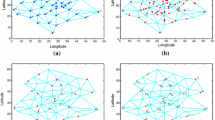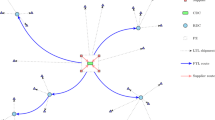Abstract
In this paper, we proposed a new DEA approach to allocate the resource in branch network system which is not covered by the existing resource allocation works under a centralized decision-making environment. The branch network system is typically appears in multi-national or multi-regional corporations, which has many branches across multiple locations. Given the spatial distribution of the production, we imposed additional restrictions on resource allocation and divided the resource inputs into three groups: fixed inputs, regional inputs that allocated to the branches in the same area and common resource that an additional resource allocated to all the branches. Then, we generalize the model further to accommodate technological heterogeneity due to the difference in the geographical locations of the branches. And the objective of the proposed models is to maximize the gross profits of the entire organization, which is a natural assumption for a for-profit organization. Finally, an example was presented to illustrate the proposed approach with heterogeneous technology is more practically feasible and superior than the prior approach with homogeneous technology.

Similar content being viewed by others
References
Amirteimoori A (2011) An extended transportation problem: a dea-based approach. Cent Eur J Oper Res 19(4):513–521
Amirteimoori A, Emrouznejad A (2012) Optimal input/output reduction in production processes. Decis Support Syst 52(3):742–747
Asmild M, Paradi JC, Pastor JT (2009) Centralized resource allocation BCC models. Omega 37:40–49
Athanassopoulos AD (1995) Goal programming & data envelopment analysis (GoDEA) for target-based multi-level planning: allocating central grants to the Greek local authorities. Eur J Oper Res 87(3):535–550
Athanassopoulos AD (1998) Decision support for target-based resource allocation of public services in multiunit and multi-level systems. Manag Sci 44(2):173–187
Banker RD, Charnes A, Cooper WW (1984) Some models for estimating technical and scale in efficiencies in data envelopment analysis. Manag Sci 30:1078–1092
Beasley JE (2003) Allocating fixed costs and resources via DEA. Eur J Oper Res 147:198–216
Charnes A, Cooper WW, Rhodes E (1978) Measuring efficiency of decision making units. Eur J Oper Res 2(6):429–444
Cook WD, Seiford LM (2009) Data envelopment analysis (DEA)-Thirty years on. Eur J Oper Res 192:1–17
Das A, Ghosh S (2009) Financial deregulation and profit efficiency: a nonparametric analysis of Indian banks. J Econ Bus 61(6):509–528
Fang L, Li H (2015) Centralized resource allocation based on the cost-revenue analysis. Comput Ind Eng 85:395–401
Färe R, Grosskopf S (1997) Profit efficiency, Farrell decomposition and the Mahler inequality. Econ Lett 57:283–287
Golany B, Tamir E (1995) Evaluating Efficiency-Effectiveness-Equality Trade-offs: a Data Envelopment Analysis Approach. Manag Sci 41(7):1172–1184
Jablonsky J (2018) Ranking of countries in sporting events using two-stage data envelopment analysis models: a case of Summer Olympic Games 2016. Cent Eur J Oper Res. https://doi.org/10.1007/s10100-018-0537-8
Kao C, Hwang SN (2009) Efficiency measurement for network systems: IT impact on firm performance. Exp Syst Appl 147:197–216
Kao C, Hwang SN (2010) Efficiency measurement for network systems: it impact on firm performance. Decis Support Syst 48(3):437–446
Korhonen P, Syrjänen M (2004) Resource allocation based on efficiency analysis. Manag Sci 50(8):1134–1144
Li H, Yang W, Zhou Z, Huang C (2013) Resource allocation models’ construction for the reduction of undesirable outputs based on dea methods. Math Comput Model 58(5–6):913–926
Liang L, Yang F, Cook WD, Zhu J (2006) DEA models for supply chain efficiency evaluation. Ann Oper Res 145(1):35–49
Lindebo E, Hoff A, Vestergaard N (2007) Revenue-based capacity utilization measures and decomposition: the case of Danish North Sea trawlers. Eur J Oper Res 180:215–227
Lozano S, Villa G (2004) Centralized resource allocation using data envelopment analysis. J Prod Anal 22(1):143–161
Lozano S, Villa G, Canca D (2011) Application of centralised dea approach to capital budgeting in spanish ports. Comput Ind Eng 60(3):455–465
Malekmohammadi N, Lotfi FH, Jaafar AB (2011) Data envelopment scenario analysis with imprecise data. Cent Eur J Oper Res 19(1):65–79
O’Donnell CJ, Rao DSP, Battese GE (2008) Metafrontier frameworks for the study of firm-level efficiencies and technology ratios. Empir Econ 34(2):231–255
Pachkova EV (2009) Restricted reallocation of resources. Eur J Oper Res 196(3):1049–1057
Ray S (2016) Cost efficiency in an Indian bank branch network: a centralized resource allocation model. Omega 65:69–81
Ray SC, Chen L, Mukherjee K (2008) Input price variation across locations and a generalized measure of cost efficiency. Int J Prod Econ 116(2):208–218
Thanassoulis E, Dyson RG (1992) Estimating preferred input output levels using data envelopment analysis. Eur J Oper Res 56(1):80–97
Toloo M, Tavana M, Santos-Arteaga FJ (2017) An integrated data envelopment analysis and mixed integer non-linear programming model for linearizing the common set of weights. Cent Eur J Oper Res 4:1–18 In Press
Toloo M, Nalchigar S, Sohrabi B (2018) Selecting most efficient information system projects in presence of user subjective opinions: a DEA approach. Cent Eur J Oper Res. https://doi.org/10.1007/s10100-018-0549-4
Varmaz A, Varwig A, Poddig T (2013) Centralized resource planning and yardstick competition. Omega 41(1):112–118
Wang QW, Zhao ZY, Zhou P, Zhou DQ (2013) Energy efficiency and production technology heterogeneity in China: a meta-frontier DEA approach. Econ Model 35(5):283–289
Wu J, An Q, Ali S, Liang L (2013) DEA based resource allocation considering environmental factors. Math Comput Model 58(5):1128–1137
Yu MM, Chen LH (2016) Centralized resource allocation with emission resistance in a two-stage production system: evidence from a Taiwan’s container shipping company. Transp Res Part A Policy Pract 94:650–671
Acknowledgements
The financial supports from National Natural Science Foundation of China (Grant Nos. 71731010, 71631006, 71771071) and USTC Foundation for Innovative Research Team (WK2040160008) are acknowledged.
Author information
Authors and Affiliations
Corresponding author
Appendix
Appendix
The method to transform the model (3) into a liner programming.
Let \( \lambda_{jk} \partial_{{i_{3} j}} = \mu_{{i_{3} \,jk}} \), \( \lambda_{jk} = \mu_{{i_{3} \,jk}} + \eta_{{i_{3} \,jk}} \), \( \eta_{{i_{3} \,jk}} = (1 - \partial_{{i_{3} }} )\lambda_{jk} \), \( \forall i_{3} ,\forall j,k \), where \( i_{3} = 1,2, \ldots ,m_{3} \), \( j,k = 1, \ldots ,n \). Since \( \lambda_{jk} = \mu_{{i_{3} \,jk}} + \eta_{{i_{3} \,jk}} \), \( \forall i_{3} ,\forall j,k \), this paper can arbitrary select each of \( i^{\prime}_{3} = 1,2, \ldots ,m_{3} \), and impose \( \mu_{{i_{3} \,jk}} + \eta_{{i_{3} \,jk}} = \mu_{{i_{3}^{{\prime }} \,jk}} + \eta_{{i_{3}^{{\prime }} \,jk}} \left( {i_{3} = 1, \ldots m_{3} ,j,k = 1, \ldots ,n} \right) \).
Then, in this paper we impose \( \lambda_{jk} = \mu_{{i_{3} \,jk}} + \eta_{{i_{3} \,jk}} = \mu_{jk} + \eta_{jk} ,\forall i_{3} ,j,k \) to preserve the linearity and convexity in the DEA model. Then model (3) can be transformed into the following linear programming model.
Since \( (\mu_{jk} + \eta_{jk} )\partial_{{i_{3} \,jk}} = \mu_{{i_{3} \,jk}} \), multiplying \( (\mu_{jk} + \eta_{jk} ) \) on constraints (A.8) and (A.9) to ensure the range of \( \mu_{{i_{3} \,jk}} \) is related to \( \partial_{{i_{3} \,jk}} \), this paper thus has
Moreover, this paper imposes constraints (A.14) and (A.15) on Model (A). The methods that transform the model (6) into a linear programming are the same with the above description, so we won’t repeat it here again.
Rights and permissions
About this article
Cite this article
Shao, Y., Bi, G., Yang, F. et al. Resource allocation for branch network system with considering heterogeneity based on DEA method. Cent Eur J Oper Res 26, 1005–1025 (2018). https://doi.org/10.1007/s10100-018-0563-6
Published:
Issue Date:
DOI: https://doi.org/10.1007/s10100-018-0563-6




